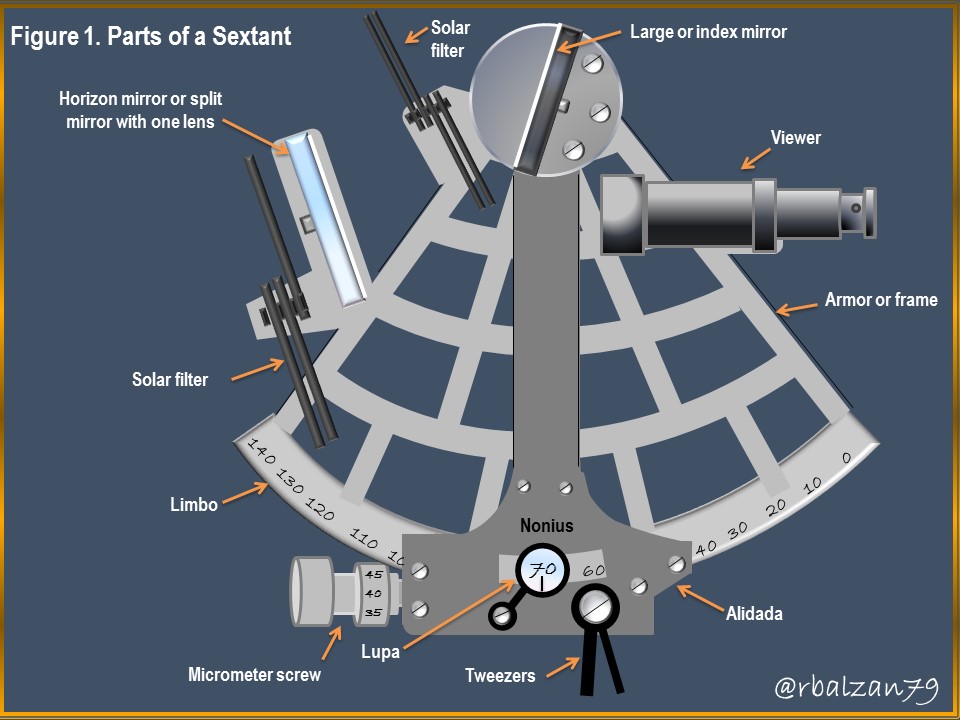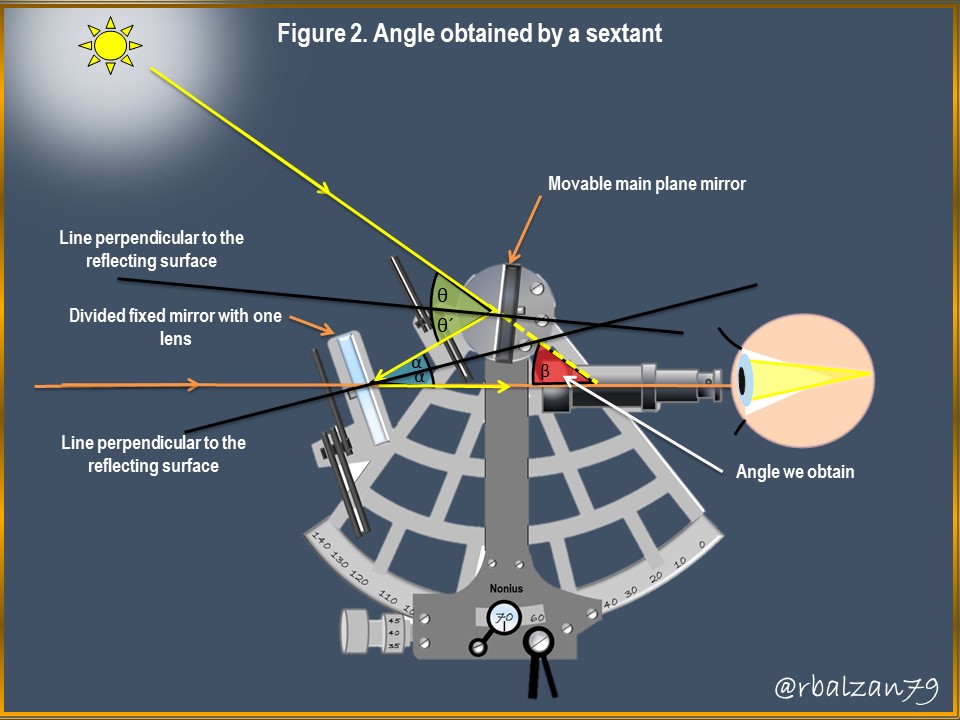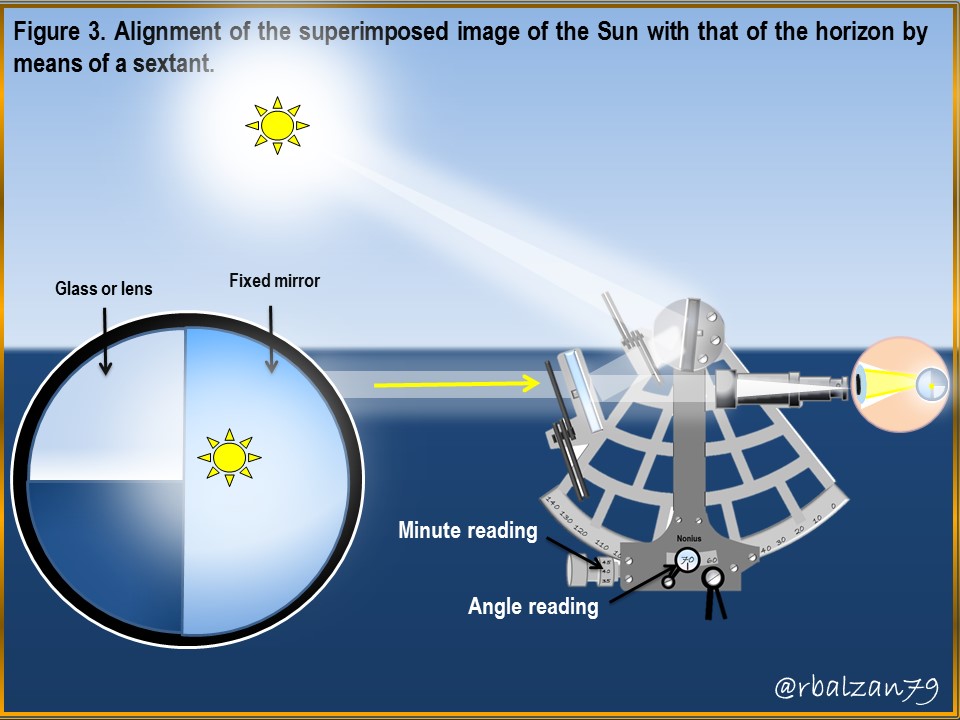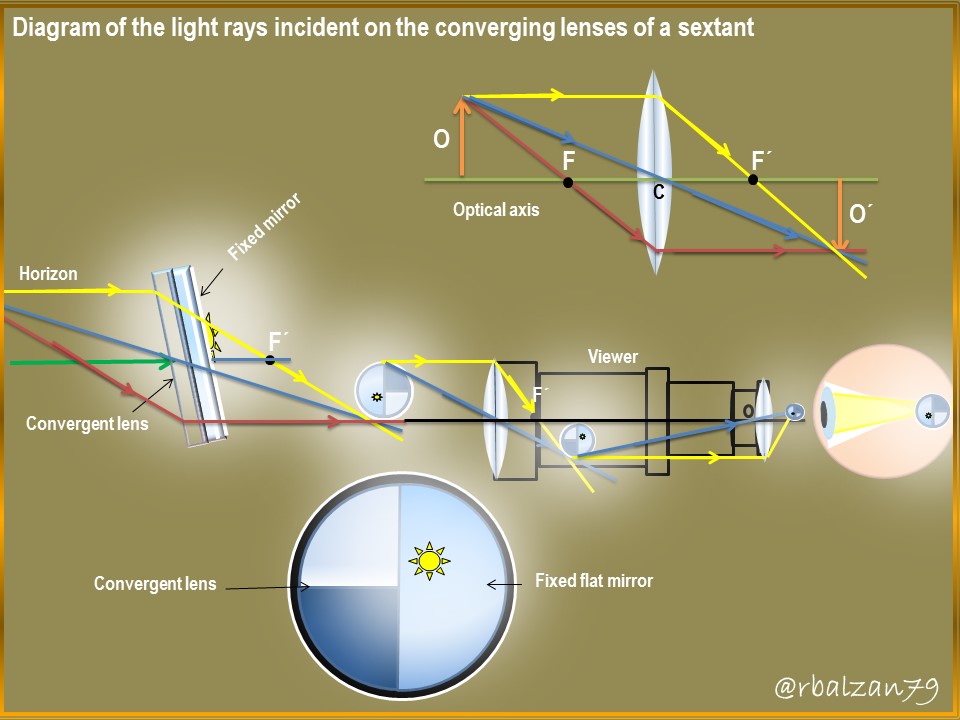Analysis of the optical elements of a Sextant

1.- Analysis and calculations of variables in the generation of images in a convergent lens.
2.- Calculations of variables in image generation in a diverging lens.
4.- Converging-converging lens arrangement in the optical system of a refracting telescope.
5.- Geometry implemented in the understanding of the algebraic formulation of thin lenses.
6.- Analysis of the arrangement of the optical system of a Newtonian reflecting telescope.
7.- Analysis of the arrangement of the optical system of a Newtonian reflecting telescope.
The sextant is a valuable optical instrument implemented to measure angles between two objects or bodies, for example, to make astronomical observations, with which calculations are made to determine the position of navigation in certain space-time where a ship is located, therefore, we can express that it is a precision instrument that among its various functions, allows us to measure the heights of the stars in our external universe, in this case, to measure vertical angles in relation to the horizon, but also angles in relation to the horizon, but also vertical angles in relation to the horizon, Therefore, we can say that it is a precision instrument that among its various functions, allows us to measure the heights of the stars of our external universe, in this case, to measure vertical angles in relation to the horizon, but also horizontal angles, before starting to analyze the generation of images in each optical element of this instrument, you can see the following figure 1.

In the previous figure 1, we could observe the parts of a sextant, among them, are the optical elements, such as, large flat mirror or index, is where, the luminous rays of the body or object that we want to obtain its angle thanks to its height with the horizon, for example, a star, that we want to implement to know its height, then, we find another flat mirror, but, this is divided, ie, one part with a flat mirror and the other half with a lens, this lens is where you can see the horizon, and the other half (the flat mirror) is responsible for sending the reflected light rays to the viewfinder (composed of converging lenses), the latter sends the final image to our retina, therefore, let us begin to know a part of the geometry implemented in this type of instrument and, for this, let us observe the following figure 2.

In the previous figure 2, we could notice the generation of the phenomenon of reflection in the two mirrors of this optical instrument, based on the law of reflection, we have that the angle of the incident light ray (θ) is equal to the angle of the reflected light ray (θ'), both angles divided by a line perpendicular to the plane mirror, then the same thing happens with the second mirror (the split mirror or divided, then these light rays reach the lenses that make up the viewfinder that is responsible for projecting the two images on our retina.
By prolonging or projecting the ray of light incident on the first mirror towards the viewfinder and coinciding with the ray of light coming from the horizon, this gives us the angle we are looking for (β) indicated by the red color, it is important to say that, through the transparent part that accompanies the second mirror is where we can observe the horizon, therefore, you can see Figure 3.

In figure 3, we can visualize the images generated by the lens or glass, as well as by the split or divided fixed mirror, this arrangement of divided mirror or with glass or lens, gives us the possibility to observe the two images that this optical instrument requires to offer us the angle related to the height of the object or body that we want to use, let's analyze the ray scheme of the flat mirrors in the following figure 4.

As in other presentations the distance of the object as the image at the same distance from the plane mirror and with the same position or orientation, this process occurs in the same way in the second divided or fixed mirror, to then pass through the converging lenses (objective and eyepiece) of the viewfinder of the optical instrument, until reaching the retina, so now, it is convenient to visualize the diagram of light rays in these converging lenses also coming from the horizon, this can be seen in the following figure 5.

In this way we were able to analyze the scheme of light rays coming from the horizon and, which cross and refract when they meet the converging lenses, such lenses characterized by generating real images, inverted (right), as long as, they are generated on the other side of the lens, that is, in the place of transmission of light rays, this occurs both, for the light rays incident on the fixed plane mirror, as well as in the other half (converging lens), to send these rays to the viewer, which projects the final image on the retina of the person observing, this procedure allows to obtain the angle of height of the astronomical body analyzed (the Sun in this case, could be from a lighthouse to the shore of a particular aquifer).
Conclusion
We continue to verify the valuable utility of any type of optical instrument, in this case the sextant, this instrument allows us to accurately measure angles between two points, as observed between the Sun and the horizon, where we point towards the sun, so that by knowing the height of the Sun and the time (time) of day, we can calculate the distance at which we are at a given time, this aspect, allows it to be very useful for navigators, astronomers and surveyors.
This beautiful optical instrument is still used, although they have been largely replaced by modern technology, such as GPS systems, however, it is very tempting for a navigator to use it and know how to perform certain calculations manually, an aspect that raises the degree of passion and knowledge in relation to navigation, it is an instrument loaded with scientific characteristics, such as geometry and optics, ie geometric optics, which this link has allowed us to learn even more about the essential phenomenon of light.
We analyze the path or scheme of light rays through each of the optical elements of this instrument, until the image is projected on our retina, this in order to continue to verify the enormous usefulness of the knowledge of optics in our lives, our existence is largely linked to obtaining the greatest possible knowledge of everything around us, aspect that through the field of science we do constantly and will be this way until the end of our existence.
Until another opportunity my dear friends.
Note: The images were created by the author using Power Point and Paint, the animated gif using PhotoScape.
Recommended bibliographic references
[1] GEOMETRIC OPTICS. Link.
[2] Convergent lenses. Link..
[3] The Sextant. Link.
[4] Images in Planemirrors. Link.
Your analysis of the sextant's optical elements is impressive. I'm curious to know how you think advancements in modern technology, such as GPS systems, have impacted the use and relevance of the sextant in today's navigation and astronomical practices. Do you believe there are specific scenarios or contexts where the sextant still holds a unique advantage over GPS technology?
Hello, thank you for your positive opinion on my article, I consider very relevant your questions, if something we have shown as humanity is to go after new advances and, especially to achieve them, many optical instruments have been improved, and even replaced by new technologies, however, the practice of any old optical instrument is recorded in our history and will be there forever, no doubt, there will be people who will continue to use it and the youngest will adapt to new technologies, the important thing is to find the balance between each technological improvement.
The use of the sextant, for example, will always have the advantage that it will depend on the skills or abilities of the person who manipulates it, on the other hand an electronic device can present some failure and if the people on board in a certain boat do not have the ability to handle a sextant will have many hardships, hence the importance of balance between technological updates with those left behind.
I constantly come across students at university level who have forgotten how to solve elementary mathematical operations by the use of calculators, we can extrapolate this to the use of many other tools, such as the sextant, we must always learn to maintain a culture of teaching in balance and, in this way we will be forming our young people integrally and prepared to face in the best way any difficulty.
I hope I have contributed in a general way to the answers of your important questions, and thanks again for your visit to my post.
I completely agree that finding a balance between embracing new technologies and preserving the knowledge and skills associated with older tools is crucial.
I appreciate the knowledge you've shared and the passion you have for your subject.
Keep up the great work, and I'm sure your insights will continue to inspire and educate others. Thank you for your contribution, and it was a pleasure.
Thanks for your contribution to the STEMsocial community. Feel free to join us on discord to get to know the rest of us!
Please consider delegating to the @stemsocial account (85% of the curation rewards are returned).
You may also include @stemsocial as a beneficiary of the rewards of this post to get a stronger support.
There are no naked pictures here. Disappointing :P
Thanks for your visit. Greetings.
Wow this is absolutely and totally cool as I'll get out and then all of your links link back to the Posts you have done...
Super awesome job wow absolutely and totally incredible I got to go check and see if I'm following you because if not I definitely got to smash that button.
I've always wanted to know more about this piece of equipment and my grandpa was a sailor so at one time I knew a lot about sailing and this kind of equipment.
Definitely an extremely amazing job!
Thank you for your great and valuable comment. Regards.
You're very welcome and thank you for your excellent content.